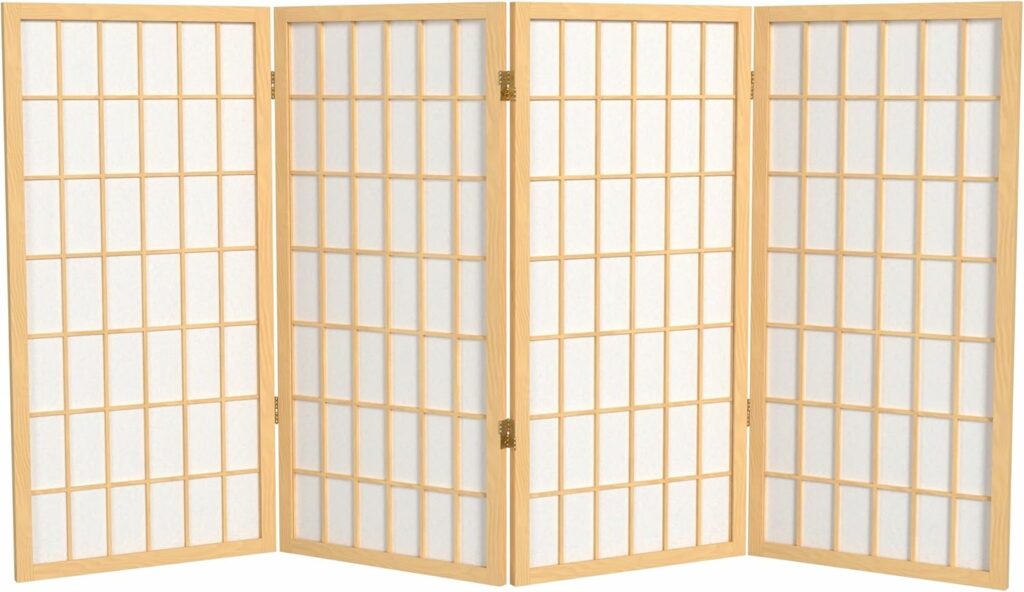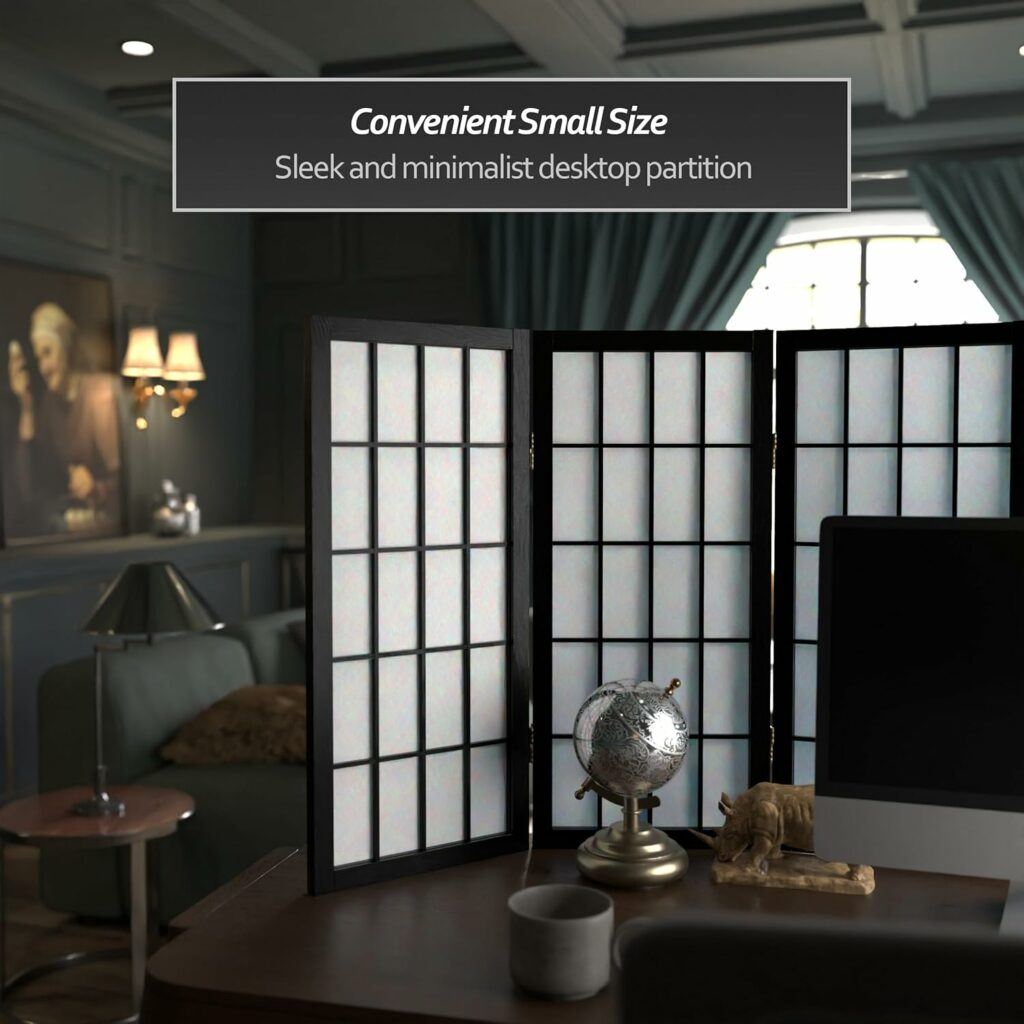Shoji screens aren’t just about separating rooms. They’re about adding that touch of elegance and tranquility you often find in traditional Japanese homes. There’s something about those translucent panels that just screams ‘zen’.
The cultural weight of Shoji screens isn’t lost on those who’ve had a chance to experience them up close.
For centuries, they’ve been a mainstay in Japanese architecture, offering more than just privacy. They bridge the connection between the indoor and outdoor spaces in a gentle, harmonious manner.
Today, these screens have found their way into homes worldwide, and for good reason. Interior designers love them for the subtle sophistication they bring.
Whether you’re hiding a cluttered area or just need a stylish partition, a Shoji screen can swoop in and save the day with flair.
And don’t get me started on their functional advantages.
Besides the obvious space-saving trait, they let in soft, diffused light, making your room glow naturally without invading your privacy.
Plus, they’re light and easy to maneuver, making redecorating less of a headache.
Whether it’s creating a cozy reading nook or turning your open floor plan into more defined spaces, a Shoji screen lets you play with your space creatively and elegantly.
It’s pretty clear why anyone with an eye for style would want one in their living space.

History and Evolution: The Journey of Shoji Screens
Shoji screens have been around for ages, deeply rooted in the history of Japanese housing and aesthetics. Their journey is long and fascinating, giving a window into how clever and thoughtful Japanese design can be.
Back in the day, these screens served practical needs, providing privacy without closing off spaces entirely.
Imagine sliding those delicate partitions instead of clunky doors. They allowed light and air to pass through, promoting healthier living environments way before it was trendy.
Fast forward to now, you’ll find that Shoji screens have evolved in many ways.
Traditional designs still hold their charm, featuring classic lattice patterns and natural materials like wood and paper. But they’re not stuck in the past.
Modern Shoji screens might come in materials like glass or synthetic panels, reflecting changes in technology and design tastes.
There’s something special about the timeless clean lines and understated elegance of traditional Shoji.
Yet, for the adventurous, contemporary versions can offer bold patterns and vibrant colors, integrating effortlessly into various modern settings.
Understanding the evolution of Shoji screens isn’t just about respecting tradition.
It’s about knowing your options and appreciating how these screens can fit into a variety of interiors, blending the old with the new in a unique way.
If you respect the traditions while embracing modern improvements, you’re more likely to find a screen that resonates with your personal style and ties your space together beautifully.
How To Choose The Perfect Japanese Shoji Screen For Your Home
Materials Matter:
When you’re in the market for a Shoji screen, the material you choose can make or break your experience with it.
Traditionally, Shoji screens have been made with a combination of thin wooden frames and washi paper.
Washi, being a super durable yet lightweight material, lets that soft glow of natural light filter through, creating that serene ambiance we all love.
Now, if you’re after something more modern or need something a bit more durable, there are lots of options to explore.
You’ll find screens made from synthetic materials like plastic, which offer more resistance to wear and tear—great if you’ve got kids or pets running around.
Glass Shoji screens have also popped up, combining traditional aesthetics with a contemporary twist.
They’re fantastic if you’re looking for something that adds a sleek finish while still retaining that open, airy vibe. Plus, they’re easy to clean, which is always a bonus.
But let’s not overlook the importance of eco-friendliness.
Some companies are now offering eco-friendly materials, which is a big win for any sustainable living enthusiast.
Where and How are you using the Shoji Screen?
As you pick the right material, think about the balance you want between maintaining that authentic look and meeting your practical needs.
Ultimately, your choice starts with assessing where and how you’ll use the Shoji screen.
Is it purely decorative, or does it need to withstand some elements of daily life? Your answers will guide you to the perfect material match for your space.
On a final note, always consider how each material might reflect on your existing décor. The right choice will not only fit your purpose but will also harmonize beautifully with your current scheme.

Design & Style
Choosing a Shoji screen isn’t just about picking a panel and calling it a day—it’s about style and finding the right fit for your space.
Traditional patterns often feature clean lines and simple grids that appeal to classic tastes. These designs celebrate minimalism, adding a touch of elegance without overwhelming the room.
For those craving a bit more flair, there are customizable options galore.
Imagine incorporating your own personal touch through colors and patterns that speak to your individuality.
This could mean opting for a screen with a scene from nature or one with abstract, geometric shapes that make a statement.
It’s important to think about how the Shoji screen will interact with your existing décor.
If your home leans into Scandinavian or minimalist designs, a simple, traditional Shoji might harmonize perfectly.
Meanwhile, eclectic or colorful spaces might benefit from a pop of modern design, drawing the eye without clashing with other elements.
Customizing doesn’t stop at colors and patterns—consider the frame material and finish, too.
Whether it’s a dark wood that exudes sophistication or sleek metal that adds an industrial edge, frame finishes can significantly alter the final look.
Remember, Shoji screens are versatile. They can blend seamlessly or stand out as a bold focal point.
Before making your choice, visualize how it will fit into your space and reflect who you are.
The best part is, that whichever style you go for, you’re enhancing your home’s aesthetic appeal with a unique touch of Japanese culture.
Functionality
Let’s talk some more about what purpose your Shoji screen will serve.
Shoji screens are incredibly versatile, not just pretty room dividers. They’re here to serve multiple functions in your home, and understanding what exactly you need from them makes the selection easier.
Consider if you’re using the Shoji screen as a partition, door, or window covering.
If you’re looking to split a large room into more intimate spaces, Shoji screens are perfect for creating cozy nooks without permanent walls.
Thinking about noise reduction and light filtering?
While these screens aren’t heavy-duty soundproof barriers, they do offer some noise insulation due to their structure.
The thin paper panels allow soft, ambient light to seep through without compromising privacy—ideal for room dividers in open floor plans.
In smaller spaces, Shoji screens can give the illusion of added space, thanks to their light-diffusing qualities. Position them strategically to maximize both physical and perceived area.
They might even double as a stylish headboard or as a creative solution for hiding clutter.
Understanding the purpose of your Shoji screen helps you pick the right size, style, and material, aligning your functional needs with aesthetic desires.
It ensures you’re not just buying an elegant piece but also a functional one that adds value to your home.
Size & Placement
Determining the right size and placement of your Shoji screen in your home is also important.
Getting the right Shoji screen isn’t just about picking the prettiest design; getting the sizing spot on is also crucial.
You need to ensure it fits the space you plan to use; balancing both function and aesthetics without overwhelming your room.
- Start by carefully measuring the area.
Always double-check because being a bit off can make a big difference when it comes to screens. Consider not just the width but also the height and how you intend to place the screen. This ensures a perfect fit whether it’s freestanding or sliding within a track.
2. Placement is key too.
If it’s going to serve as a room divider, think about how it will affect movement within the space. You want to enhance flow, not disrupt it, so positioning it strategically is important.
For windows, ensure they’re aligned properly to let in or block light as you prefer.
3. Adaptability is another great feature of Shoji screens
Some can be retractable or movable, offering flexibility based on your needs. If you love changing your interiors around, a movable option could be your best bet—easy to adjust and adapt to new layouts.
4. Scale to your furniture and room size
Besides basic dimensions, remember scale in relation to your furniture and room size. A massive screen in a tiny space might make the room feel cramped while a too-small screen in a sprawling room will seem out of place.
Aim for harmony in size relative to surroundings for that perfect fit.
Maintenance and Care:
Let’s take a look at how to keep your Shoji screen in top condition.
Keeping your Shoji screen looking fresh and elegant doesn’t require a massive effort but knowing some handy tips can certainly prolong its life.
The delicate materials involved, like washi paper and wood, need gentle handling to maintain their beauty over time.
- Regularly dusting the wooden frame with a soft cloth helps keep marks and dirt at bay.
- Avoid any harsh chemicals here, as they can damage the finish.
- For more stubborn spots, a simple damp cloth will usually do the trick.
The paper panels, being more delicate, avoid direct moisture.
Use a soft brush or feather duster to clean dust or cobwebs. If a tear occurs, minor damages can often be fixed with patching kits available at many home stores or online.
If the tear is extensive, rescreening might be necessary, giving your screen a new lease on life.
Keep them away from direct sunlight.
When it comes to longevity, keeping them away from direct sunlight is key to preventing fading and wear. This also helps protect against any potential warping or material degradation that high heat can cause, particularly with wooden frames.
Preventative care is always best.
Place your Shoji screen in spots where it’s less likely to be knocked, especially if you have kids or pets. This ensures less wear and tear, keeping things as fresh as the day you bought it.
Seasonal maintenance checks
Consider seasonal maintenance checks to tighten any loose screws or joints, ensuring your Shoji retains its sturdy and stable form. A little care goes a long way in keeping this elegant piece a permanent part of your home décor.
Technological Innovations
Shoji screens have come a long way, blending traditional charm with modern tech. Integrating modern innovations without losing that classic touch has made them even more versatile and appealing.
1. Smart home integration is one of the coolest additions.
Imagine pairing your Shoji screen with smart home devices where they open or close with a voice command or via a mobile app. This tech-savvy upgrade isn’t just convenient; it adds an ultra-modern touch to your living space.
2. Soundproofing elements
Speaking of innovations, there are Shoji screens now equipped with soundproofing elements. While they won’t make your room a fortress of silence, they do a decent job in muting down ambient noise, adding extra functionality beyond their aesthetic appeal.
3. Eco-friendly materials
Sustainability is a major selling point today, and it’s no different with Shoji screens. Opt for eco-friendly materials if you aim to reduce your carbon footprint.
Many modern versions are built with sustainable wood sources and recycled materials, catering to the environmentally conscious.
4. UV-protected panels
Enhancements even extend to materials and design patterns. Think UV-protected panels or fire-retardant materials for added safety features without compromising the delicate look of traditional Shoji screens.
This is particularly useful if you’re setting them up in high-traffic areas or places with strong sunlight exposure.
These innovations mean maintaining the serene beauty of Shoji screens while making them fit seamlessly into 21st-century homes.
It’s about adding value and usability, ensuring they’re more than just static decor but vital components of your modern living experience.
Recommendation
We hope that this article on how to choose the perfect Japanese Shoji screen for your home has been insightful and that you are confident and informed to make the right decision about the Shoji screen selection.
Choosing the perfect Shoji screen for your home might seem like a detailed process, but by now, you’re all set to make a choice that blends functionality with style.
Picking the right design and material isn’t just about aesthetics; it’s about enhancing your space in a way that reflects your personality and meets your needs.
Remember, a Shoji screen isn’t just another piece of décor—it’s an investment that adds value to your home.
Whether you’re going for a traditional touch or incorporating the latest tech, each choice speaks volumes about your style and practical needs.
It’s crucial to look at all factors: the purpose of the screen, how it fits into your existing space, and the ease of maintenance.
Those considerations make your investment worthwhile, ensuring your Shoji screen remains as stunning as it is functional.
Stay true to your personal style while considering practicality, and you can’t go wrong.
A well-chosen Shoji will not only divide your rooms but also add harmony and character to your living space, embodying the essence of Japanese elegance.
